
Before we talk about the comparison and contrast between Scrum Master and Agile Leader, people often compare and contrast Scrum Master and Agile Coach, and they often ask me, what’s the difference?
The oversimplified answer is $200 per day because a Scrum Master should be working at an organizational level. The oversimplification comes from assuming that people have to do scrum. Of course, they might use some other approaches. However, I think in the current setup, scrum is the most popular approach (rightly or wrongly) in the market. If an “agilist” is unfamiliar with it, I think it says a lot.
That said, people can use other approaches and a decent scrum master should be aware of such approaches. They should be well versed on product management, design, other agile and lean agile approaches.
As a Scrum Master, you should not only have scrum in your toolbox. Scrum.org offers a Scrum with Kanban workshop and Scrum with UX workshop as well. This demonstrates that they are open to other approaches.
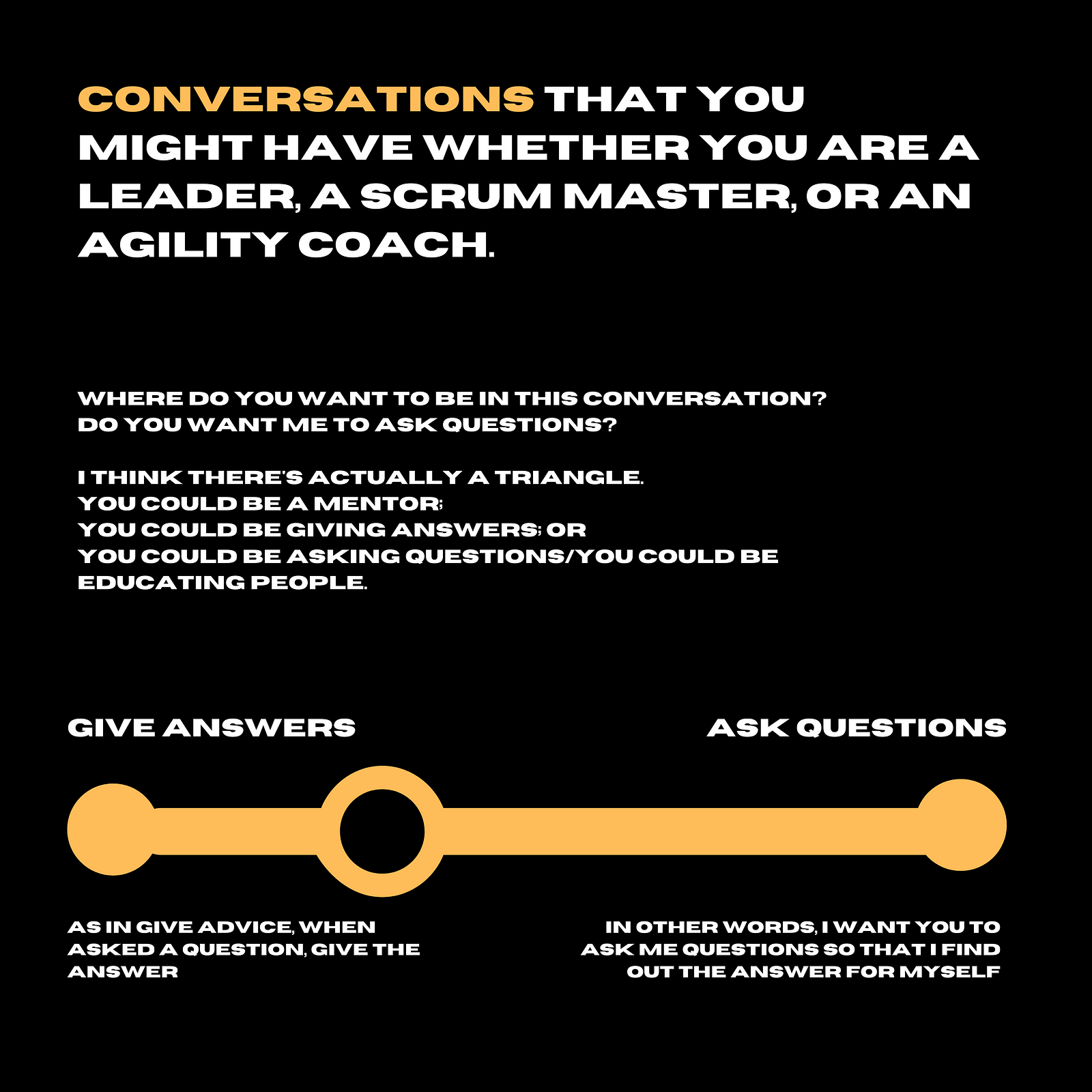
Let us go into the conversations that you might have whether you are a leader, a Scrum Master, or an agility coach. A friend of mine said to me years ago, that he used to draw a line, and:
- at one end of the line, he would draw a little circle and say, give answers (as in give advice, when asked a question, give the answer).
- at the other end of the line, he had another little circle saying, ask questions (in other words, I want you to ask me questions so that I find out the answer for myself).
This “sliding scale” approach to coaching defeats the notion that “professional coaching is a bit binary”.
My friend used to say to people:
- where do you want to be in this conversation?
- do you want me to ask questions?
I think there’s actually a triangle.
- You could be a mentor;
- You could be giving answers; or
- You could be asking questions/you could be educating people.
For all of these, my position is, that I want to ask for permission.
Tom Mellor gave me a tip some years ago, he said, “John, don’t ever give advice unless people ask for it”(He was giving me advice when he said that, so there was a bit of a paradox there) but I appreciated that tip.
In other words, let us not inflict help on people.
People might want you to give advice. Typically, when people are less familiar with agility, they expect answers. As they get more agile, they expect to be coached (maybe), to find the right answers for themselves.
When you as a scrum master or leader detect that the people in front of you aren’t aware of some additional options, where essentially they do not know what they do not know, what I would do in that scenario is I would ask for permission to just go into a 10 or 15 minute teaching moment.
I tend to base my conversations on pull, not inflicting help on people, inviting, not imposing, asking for permission to either give advice, to ask questions, or to educate.
What do I expect a Scrum Master or an Agility Coach to do?
Disclaimer: This would be like a 2021 personal opinion in terms of what a scrum master should be doing. I think the nuance you might see here is the focus on understanding product management and design more.
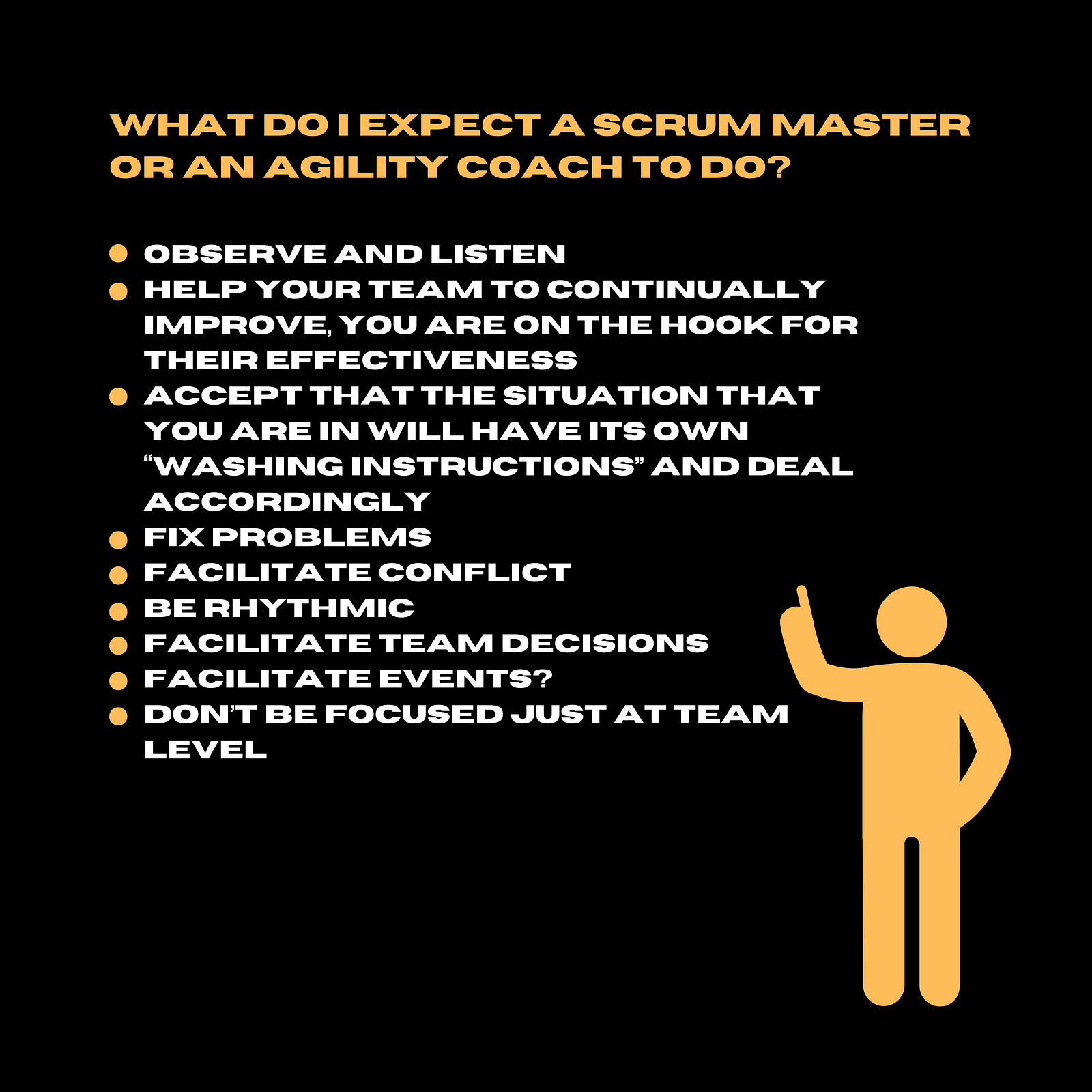
Observe and Listen
The first thing I would expect is that you would observe. You would listen and you would learn about the domain as well (the technical domain, maybe also the business domain).
Do not be so quick to jump in with solutions, particularly in non-software, and non-tech. There can be a tendency for people to jump in, and a lot of the Agile approaches were designed for software.
Be careful about assuming that it will just work in any other domain. You need to understand the context and learn (I’ve had people teaching me about rock pressure, for example, when I was working in an oil company).
Help your team to continually improve, you are on the hook for their effectiveness
The second thing is, you should be helping the team to continually improve:
- If they are using Scrum, your team will probably be doing retrospectives.
- If you are doing some other kind of Lean Agile, you might be using Kaizen, where you agree to continually improve or continuously improve.
Regardless, there should be improvements. Encourage that improvement.
In the 2020 Scrum Guide, the Scrum Master is actually on the hook for the effectiveness of the Scrum Team. So if the team is not improving, we can look at the Scrum Master.
Accept that the situation that you are in will have its own “washing instructions” and deal accordingly
The other thing I would say is, from a Cynefin Sense-Making point of view, you need to accept that the situation that you are in will have its own washing instructions. I love the “washing instructions” metaphor from Pia Maria Thoren used when I interviewed her on the Xagility podcast. People have their own washing instructions. Teams have their own washing instructions. In other words, you treat them differently. They do not all use the same approach. They might not even all use scrum, for example.
From a a Cynefin Sense-Making point of view (if you are not familiar with Cynefin, maybe just Google Cynefin executive and a video will come up where I explained it in 15 minutes), there are five domains there. Depending on which domain you are in, you might want to act differently. So accept that the situation will have its own reaction type.
Fix problems
A Scrum Master should be fixing problems, but I hope people in the team are fixing their own printers. I hope the team has already tried to fix the problems they’ve come across. Once the scrum master takes this up, we really are trying to fix that problem (remove that impediment, as we say in Scrum) and they never give up.
The Scrum Masters that irritate me are the ones who give up. They just accept that things are crap around here and they do not continue to improve, and then they just become part of the problem rather than really trying to help. They are just getting into the mechanics rather than really trying to improve.
You are not really agile if you’re not improving, if you’re not fixing problems.
In one context, I had two teams and when I onboarded them to support them, they expressed a desire for me to help them. I discovered that each of those teams had an impediment that was seven years old. That is not a good sign. I was all over those issues like a rash. People were wondering what was going on as this had been like this forever. It is not good enough. So as a scrum master, I would be all over that.
Facilitate conflict
Scrum Masters should be facilitating conflict. If there is healthy conflict, that is fine because we want people to find the truth, the right idea. If there is unhealthy conflict and people are making personal comments to each other and getting a bit emotional and talking based on principles and so on, that’s not so good. As a Scrum master, you need to be managing that, facilitating that conflict, I would say, and also facilitating a purposeful rhythm.
Be rhythmic
You get teams where people would say “ah well, such and such was on holiday this week, we should do a retrospective next week instead”.
They’re just excuses. There’s always somebody on holidays or something going on, so just be rhythmic, really, about your events, whatever events you have. If it is Scrum you’ve got the daily scrum every day, if you’re planning that day, you still have a daily scrum. Be really rhythmic about that.
Facilitate team decisions
Facilitating team decisions when teams are struggling to make decisions, not being the chairperson, but facilitating the discussion so that we can be fruitful. You might pull out six thinking hats out of your hat, for example, to help the team unlock some decision-making and also as a Scrum Master facilitating large groups.
Facilitate events?
I do not really expect the Scrum Master to be facilitating the events. Maybe the retrospective is the only one and even then that might be rotated amongst the team members. I think a good scrum master should have large group facilitation skills, and probably should be familiar with liberating structures, open space, lots of innovation games, and so on, different ways of making sure that we can be productive as a large group.
Don’t be focused just at team level
The Scrum Master should not be just focused on the team level, they need to be working at an organizational level, team of teams, teams that we interact with, and so on to make sure that the issues that are beyond the limits of the team are being dealt with, that we are not just accepting processes that are incongruent with agility.
We are trying to either delete or change some of them so that there is less friction. Scrum masters should be broad and deep, focused on outcome oriented agility, not just pure feature factory-type delivery. They must be clued into what is going on in product management design and also technical (I would say).
While a scrum master does not have to be technical as per the Scrum Guide and LeSS (large scale scrum), we prefer the scrum master to be technical to have more credibility in terms of what is going on and understanding what is actually going on.
Avoid

A few things that we would probably like you to avoid as a scrum master/ agility coach are:
- not being a kind of police person;
- not being a secretary or admin;
- not inflicting help on the team;
- not being the chairperson; and
- not being a superhero.
These are things that we would discourage in a scrum master.
We need to move past agility being about delivery. It was never really all about delivery, but it has become misunderstood as that. So discovery, the focus on discovery is going to be crucial as we move forward.
That’s the Scrum Master or agility coach.
What about a leader? It’s quite similar actually.
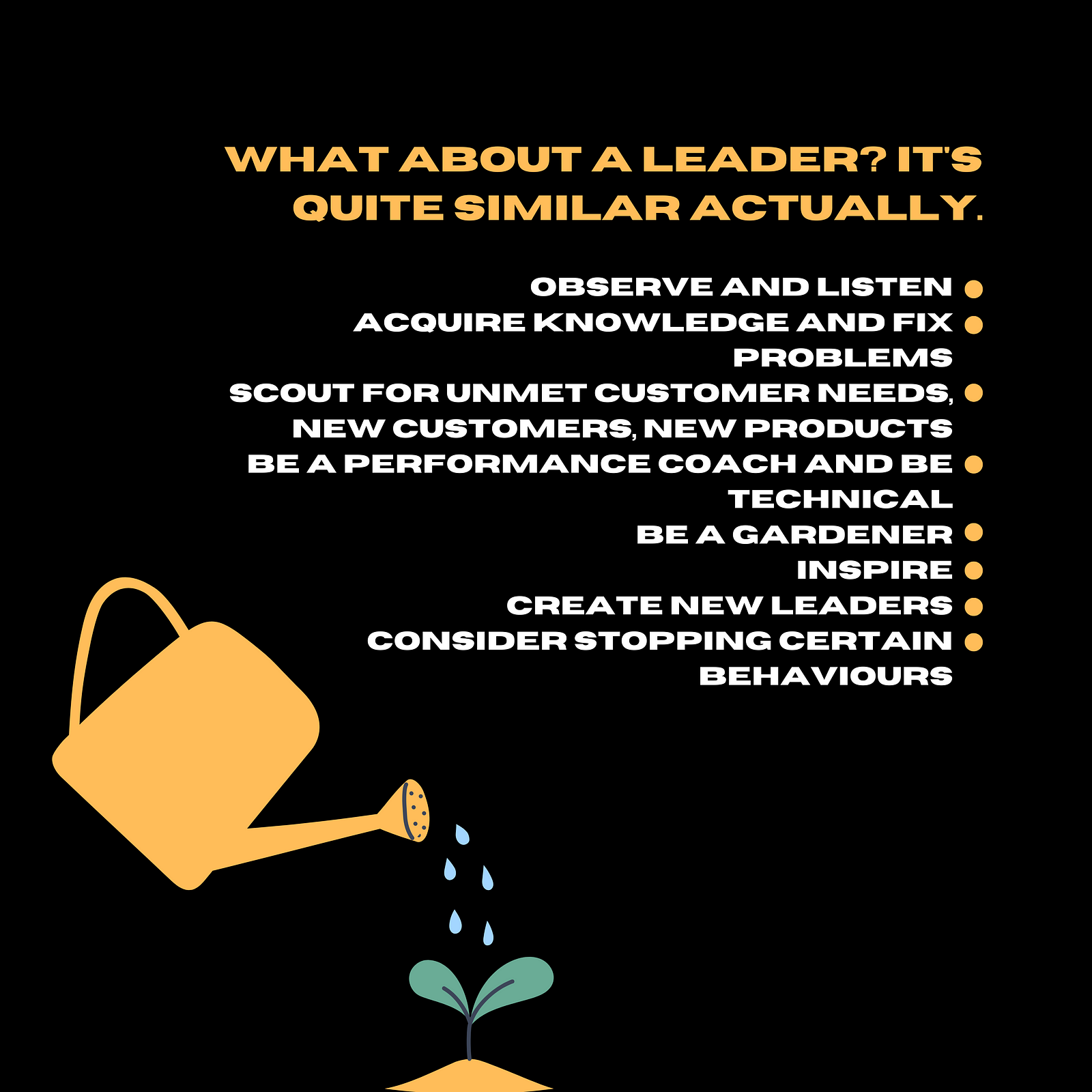
Observe and Listen
Still observe, still listen. Except maybe we expect you to go a bit deeper in terms of observation. Go see and really see what’s going on.
Acquire knowledge and fix problems
Acquiring knowledge about what is going on in the system. Focus on still fixing problems. A leader has more power to fix problems. Again, the leader needs to be (I will not say use situational leadership because that has a meaning) accepting that the situation will have its own “washing instructions” just like with the Scrum Master looking at what Cynefin domain we are in and thinking about which way we react accordingly.
Scout for unmet customer needs, new customers, new products
A key difference I would think between a Scrum Master Agility Coach and a Leader would be, that the Leader would be scouting for unmet customer needs, would be scouting for new customers, new products, and they would do that through discovery.
A good Scrum Master would support this, but a really good leader would understand that most ideas should never be born. We should do experiments to assess whether some of these are really going to fly or not, and even then they might not fly, but we try to use evidence to inform our decision-making.
Be a performance coach and be technical
A leader should be a performance coach, not just in terms of individuals, but in terms of teams, helping the teams to be more effective. A good leader would be technical and would understand what’s going on. So if they do not really understand the technicalities of what they are doing, (particularly if people’s lives could be at risk), my view is that a leader should be technical.
Be a gardener
A leader is a gardener. They are trying to cultivate the environment for agility, and they might be changing or deleting processes and workflows that impede agility. It is very similar to a scrum master in that regard, just that the leader is more of a gardener, whereas the Scrum Master is trying to convince the leaders (convince is probably the wrong word)/ encourage leaders to be gardeners. So almost like the coaches for the leaders.
Inspire
A leader should inspire, which would be another difference as well. A scrum master or agility coach would inspire from the point of view of why we are doing agility — understanding you are trying to get alignment in the organization about why we are doing agility and then helping teams to figure out what way they can achieve that and encouraging self-management and so on.
A leader should:
- inspire herself and others; and
- co-create the direction of travel — where are we going; and
- be a catalyst for what we call aligned autonomy.
So encouraging autonomy and teams, but also alignment. Alignment behind some kind of direction that we are going in. So very, very similar.
Create new leaders
In addition to that, you have “creating new leaders”. A really good leader will create new leaders without leadership actually being a position. There would be promoting self-management, promoting self-designing teams, focus and flow.
You cannot really have flow if you do not have prioritization. So focusing on:
- prioritization;
- having less backlogs;
- encouraging the backing of the Scrum Master when we are trying to be really rhythmic about our events and so on;
- promoting improvement (the opposite of complacency);
- promoting people being comfortable with being uncomfortable. That maybe we don’t know when we’re going to deliver. Maybe we need to be living with a probabilistic forecast, which still might be smoke and mirrors, but a lot better than a cast iron guarantee we will deliver by a particular date and then get a ransom note one month beforehand saying we need another 5 million.
- promoting backstage leadership;
- promoting people being technical and promoting data informed decision making.
Consider stopping
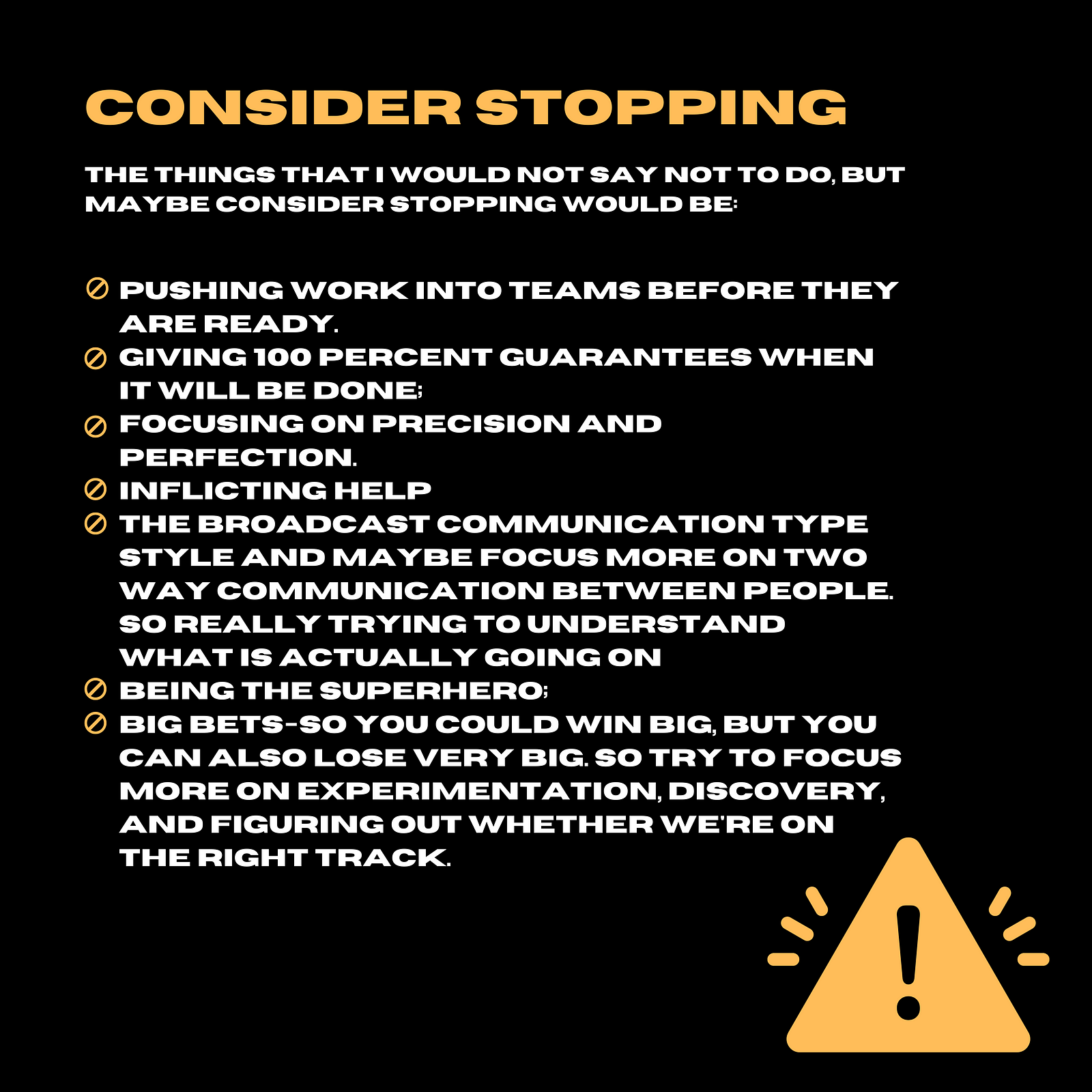
The things that I would not say not to do, but maybe consider stopping would be:
- pushing work into teams before they are ready. They will pull it when they’re ready. I am not saying never do it, but it’s something you should consider stopping;
- giving 100 percent guarantees when it will be done;
- focusing on precision and perfection. Sometimes good enough is good enough. Context matters and so on, but just be careful about that;
- again, not inflicting help, although sometimes as a performance coach, a leader will need to step in;
- the broadcast communication type style and maybe focus more on two way communication between people. So really trying to understand what is actually going on, be careful about that. Just ensuring that you are really trying to listen to what is actually going on;
- not being the superhero;
- big bets — so you could win big, but you can also lose very big. So try to focus more on experimentation, discovery, figuring out whether we’re on the right track, rather than putting a massive bet saying we’re definitely on the right track.
So what does the Scrum Master/Agility Coach do? And what does an Agile Leader do?
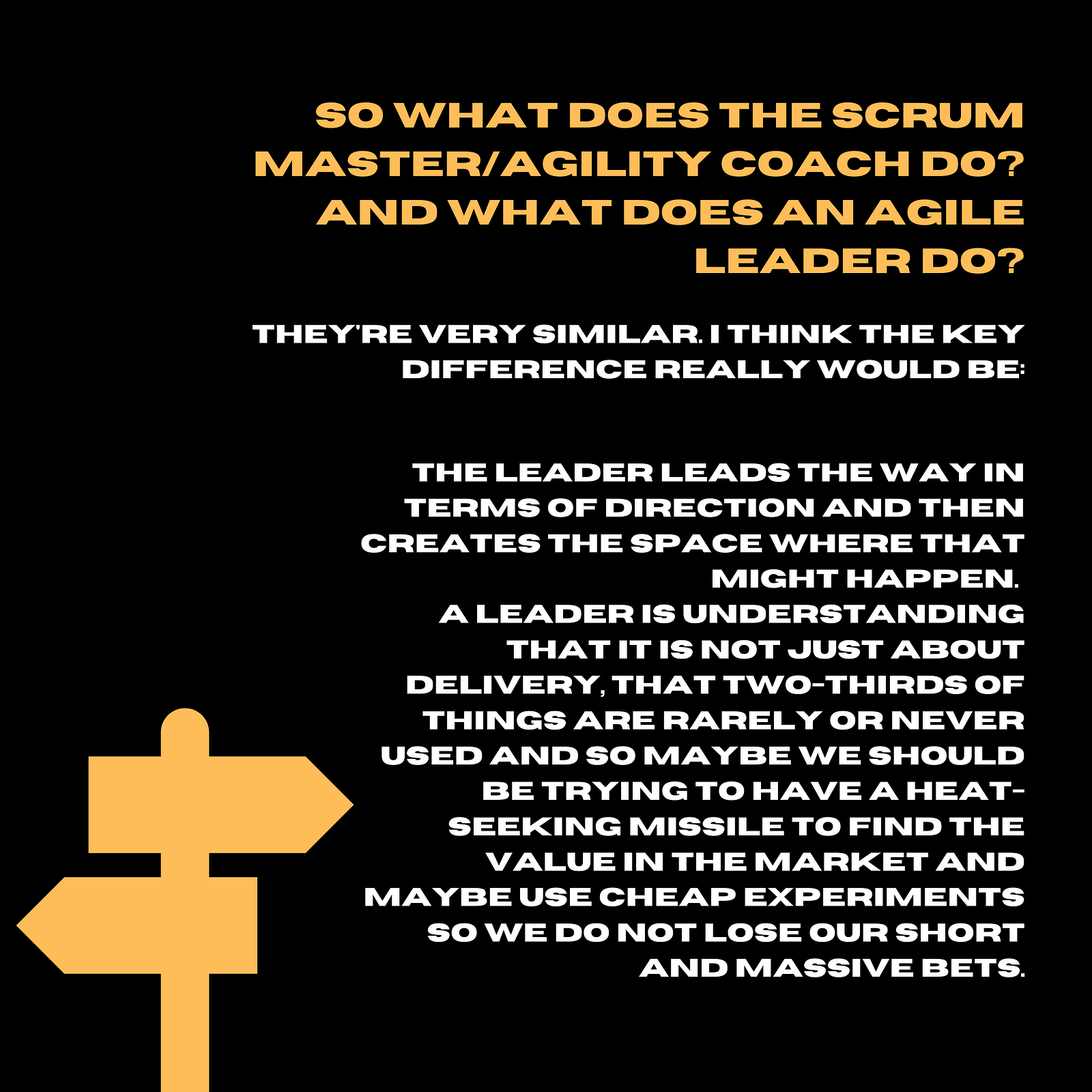
They’re very similar. I think the key difference really would be:
- the leader leads the way in terms of direction and then creates the space where that might happen. A leader is understanding that it is not just about delivery, that two-thirds of things are rarely or never used and so maybe we should be trying to have a heat-seeking missile to find the value in the market and maybe use cheap experiments so we do not lose our short and massive bets.
Even if we have loads of money, we can be making even more money, and have much happier customers if we try to laser in on the customer and meet customers.
The focus on inspiration in terms of direction, scouting through discovery and meeting customers, and also basically being a gardener, they would be the key differences, I would say.
But then the Scrum Master/Agility Coach would be encouraging the leader to do exactly that under the organizational wide change agent responsibility that I have pointed out in this particular article.
So they are, what I see as the key differences between Scrum Master, agility coach and a leader.
Thank you.
